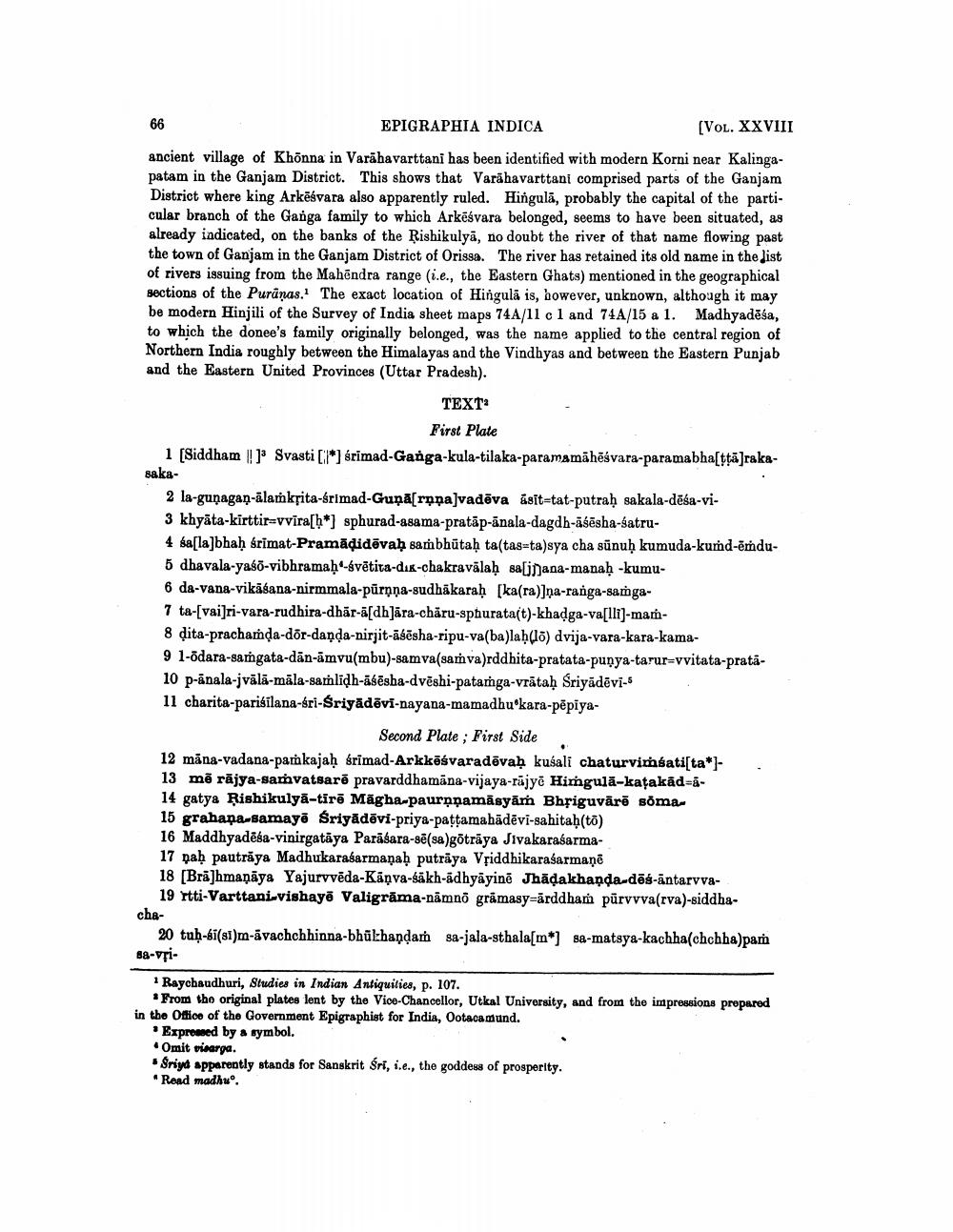________________
EPIGRAPHIA INDICA
(VOL. XXVIII
ancient village of Khõnna in Varāhavarttani has been identified with modern Korni near Kalingapatam in the Ganjam District. This shows that Varahavarttani comprised parts of the Ganjam District where king Arkēsvara also apparently ruled. Hingulā, probably the capital of the particular branch of the Ganga family to which Arkēśvara belonged, seems to have been situated, as already indicated, on the banks of the Rishikulya, no doubt the river of that name flowing past the town of Ganjam in the Ganjam District of Orissa. The river has retained its old name in the list of rivers issuing from the Mahöndra range (i.e., the Eastern Ghats) mentioned in the geographical sections of the Puranas. The exact location of Hingulä is, however, unknown, although it may be modern Hinjili of the Survey of India sheet maps 74A/11 ol and 74A/15 a 1. Madhyadēsa, to which the donee's family originally belonged, was the name applied to the central region of Northern India roughly between the Himalayas and the Vindhyas and between the Eastern Punjab and the Eastern United Provinces (Uttar Pradesh).
TEXT
First Plate 1 [Siddham !]Svasti Cl*) érimad-Ganga-kula-tilaka-paramamāhēsvara-paramabha[ttā]rakasaka
2 la-gunagan-ālamkrita-śrimad-Gunā[ropa)vadēva asit-tat-putraḥ sakala-dēša-vi3 khyāta-kirttir=vvira[h*) sphurad-asama-pratāp-ānala-dagdh-asēsha-satru4 sa[la]bhaḥ śrimat-Pramāạidēvaḥ sambhūtaḥ tastasta)sya cha sūnuḥ kumuda-kumd-ēmdu5 dhavala-yaśő-vibhramaḥ -svētita-dık-chakravālaḥ saljnana-manaḥ -kumu6 da-vana-vikisana-nirmmala-pürnna-sudhākaraḥ [ka(ra)]na-ranga-samga7 ta-[vai]ri-vara-rudhira-dhār-ā[dh]āra-chāru-sphurata(t)-khadga-va[lli)-mam8 dita-prachanda-dor-daņda-nirjit-āsēsha-ripu-va(ba)lah(lo) dvija-vara-kara-kama9 1-odara-sargata-dan-amvumbu)-samva(samva)rddhita-pratata-punya-tarur-vvitata-prata10 p-anala-jvālā-māla-samlidh-āšēsha-dvēshi-patamga-vrătah Sriyadēvi-5 11 charita-parisilana-sri-Sriyādēvi-nayana-mamadhukara-pēpiya
Second Plate ; First Side 12 māna-vadana-pamkajaḥ śrimad-Arkkēśvaradēvaḥ kusali chaturvimśatista*)13 mē rājya-samvatsarē pravarddhamāna-vijaya-rājyë Himgulā-katakād=&14 gatya Rishikulyā-tirē Māgha-paurạnamāsyām Bhriguvārē soma15 grahapa-samaya Sriyādēvi-priya-pattamahädēvi-sahitah(to) 16 Maddhyadēsa-vinirgatāya Parāsara-sē(sa)gotrāya Jivakarasarma17 pah pautrāya Madhukarasarmanah putrāya Vriddhikaraśarmani 18 Brä]hmanāya Yajurvvēda-Känva-sakh-adhyayinē Jhadakhanda-dēs-antarvva
19 rtti-Varttani-Vishayē Valigrāma-nāmno grāmasy=ārddham pūrvvva(rva)-siddhache
20 tuh-bi(si)m-avachchhinna-bhükhanda sa-jala-sthala[m*) sa-matsya-kachha(chchha)pam 88-vpi
1 Raychaudhuri, Studies in Indian Antiquities, p. 107.
* From the original plates lent by the Vice-Chancellor, Utkal University, and from the impressions prepared in the Office of the Government Epigraphist for India, Ootacamund.
Expressed by a symbol.
Omit visarga. . Sriyd apparently stands for Sanskrit śri, i.e., the goddess of prosperity. * Read madhuo.




